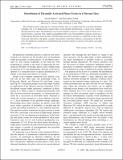Distribution of Thermally Activated Plastic Events in a Flowing Glass
Author(s)
Schuh, Christopher A.; Rodney, David
DownloadRodney-2009-Distribution of Ther.pdf (743.4Kb)
PUBLISHER_POLICY
Publisher Policy
Article is made available in accordance with the publisher's policy and may be subject to US copyright law. Please refer to the publisher's site for terms of use.
Terms of use
Metadata
Show full item recordAbstract
The potential energy landscape of a flowing metallic glass is revealed using the activation-relaxation technique. For a two-dimensional Lennard-Jones system initially deformed into a steady-state condition through quasistatic shear, the distribution of activation energies is shown to contain a large fraction of low-energy barriers, consistent with a highly nonequilibrium flow state. The distribution of plastic strains has a fundamentally different shape than that obtained during quasistatic simulations, exhibiting a peak at finite strain and, after elastic unloading, a nonzero mean plastic strain that evidences a polarization of the flow state. No significant correlation is found between the activation energy of a plastic event and its associated plastic strain.
Date issued
2009-06Department
Massachusetts Institute of Technology. Department of Materials Science and EngineeringJournal
Physical Review Letters
Publisher
American Physical Society
Citation
Rodney, David , and Christopher Schuh. “Distribution of Thermally Activated Plastic Events in a Flowing Glass.” Physical Review Letters 102.23 (2009): 235503. (C) 2010 The American Physical Society.
Version: Final published version
ISSN
0031-9007